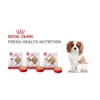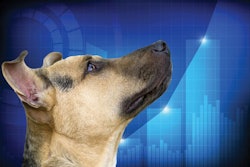
It’s apparent that the pet food business is in many ways a four-legged mirror of human food trends. There’s some momentum now for higher-quality, protein-forward, grain-free diets with a focus on improved nutritionals populated with real food ingredients. This is a reflection of consumer belief that better, healthier food is linked to a higher quality life — for themselves and for their pets.
Today a dominant trend in human food is the demand for greater transparency, visibility to the supply chain and verified integrity in product labeling — now also spilling over into the pet food arena. This shift sets the table for new technology solutions that could help both human food and pet food brands fully authenticate their nutrition and product quality bona fides.
Until now there’s been no real sustainable, cost-effective path to trace product and ingredient activity and performance throughout the supply chain. The premise of Blockchain is verified, validated processes and visibility to those steps throughout product creation and distribution. With Blockchain, pet food brands would have real data to support trusted claims of ingredient integrity, faithfulness to nutritional standards, quality commitments, labeling accuracy and food safety.
In human food, “We know the majority of people don’t trust information about the food they eat,” said Phil Harris, president and co-founder of Ripe.io, a San Francisco, California, USA-based company pioneering the Internet of Food. “And between 10 to 20 percent of them would be willing to pay more for verified quality. The value proposition for Blockchain is to unlock information desired by consumers about why they are choosing one product over another.” According to Harris, the same can be said for pet food.
Change is coming to pet food
In 1995, when the internet finally got real traction, no one really anticipated the incredible sea of change it would create in virtually every facet of how business is conducted and pet food brands are built. Similarly, Blockchain is poised to usher in another transformative period: bringing the benefits of digital technology to the pet care industry, offering an electronic upgrade to every aspect of supply chain activity and how products go to market. The late business management educator Peter Drucker summed it up: “What’s measured, improves.”
Not just for the financial sector
Blockchain has already secured a presence in other businesses, including financial services where it originated, insurance, healthcare and the nascent crypto-currency category, Bitcoin. Kodak Company, once considered virtually dead, recently announced their introduction of Blockchain with photographers to protect and monitor copyright infringements and royalty payments. Kodak is using a Bitcoin-like currency to enable purchase of usage rights for registered photos. Kodak’s share value has tripled since the announcement.
Harris said he believes pet food and its related agriculture are ideal candidates for this technology. Most likely, the first in will be pet food innovators looking for a competitive advantage and a tech-enabled path to answering the consumer’s demand for super transparency.
What is Blockchain?
Blockchain technology employs sensors, scanners and algorithms that can digitize nearly every aspect of food production workflow.
“More than ever before, stakeholders — both retail trade and consumer — care about transparency and trust in the supply chain,” said Harris. “Up until now there’s not been an efficient way to monitor practices or activities along the path.” More specifically, Blockchain can monitor how livestock or fruits and vegetables are maintained, to steps in pet food making, to processing and shipping, to finished product handling from farm to store shelf.
Digital ledgers and smart contracts
Blockchain builds a digital ledger of how pet food is made and enables smart contracts with participating companies along the path. Smart contracts can then trigger vendor payments based on verified performance at each step — from ingredient delivery to safe handling in storage and transportation to a retail outlet — all to spec. Harris said he believes that over time the smart contracts will create efficiencies and help deliver cost savings throughout the manufacturing and distribution process.
At the production plant, the flow of product from warehouse to production line and packaging can be tracked, verifying compliance with accepted methods or protocols followed by the company. With a preference now among pet food buyers for ingredients sourced in North America rather than China, this claim can be verified and trusted through Blockchain. “It’s an elegant tool,” said Harris, “that brings multiple parties together and creates attested outcomes during the journey.”
In effect, Blockchain installs a “web of trust” by delivering traceability around evidence of performance. The pet parent benefit is proof of ingredient claim and quality, essential to telling the brand’s story in a more credible way.
Data security
Blockchain’s cloud-based system and deployment of sensor technologies (where feasible) removes human intervention. In doing so, it creates authenticated trust and then enforces this condition by making alteration to digital ledgers extremely difficult.
“All records related to [pet food] manufacture are sitting in a digital ledger in the cloud,” said Harris. “Any proprietary or custom practices along the manufacturing path can be suppressed. The integrity of confidential information is maintained and there is security around who can access information. Once collected it is very difficult to change the data, thus enabling trusted performance.”
Some examples of Blockchain’s relevance to pet food via digital oversight capability include:
- Verifying claims made about proteins from grass-fed animals or cage-free raised birds.
- Real-time monitoring, recording of ingredient storage temperatures and other safety characteristics and environmental conditions.
- Authenticating organic declarations or absence of allergy-sensitive ingredients.
- In the case of a product recall, pet food makers can track product all the way back to the source in seconds rather than days.
Ripe.io and the Blockchain tomato case
Harris’ company created an initial Internet-of-Food technology pilot project in collaboration with Ward Berry Farm near Boston, Massachusetts, USA. The goal: deliver verified quality and improved flavor in tomatoes to one of Ward’s most important customers, the salad-centric Sweetgreen restaurant chain.
Ripe.io deployed Blockchain and sensors to monitor ripeness, color and sugar content in Ward’s tomato fields. Scanners were used to assess salt and PH levels. Environmental conditions such as light, humidity and air temperature were also tracked. Once harvested and in distribution, sensors recorded humidity and temperature conditions as tomatoes made their way to Sweetgreen’s kitchens.
“The outcome was better quality, optimally harvested tomatoes with a verified story Sweetgreen could use in efforts to tell customers about ingredients in their menu items,” said Harris. Sweetgreen was able to specify salty versus sweet flavor profiles and trust the tomatoes they received would deliver on that requirement.
Blockchain’s marketing value
Trust is a critical component of successful pet brand marketing in the age of consumer control. It is an active element in marketing strategy. What’s changed is the consumer’s desire for credible validation of truth, and their interest in knowing what goes on behind the curtain in pet food product creation.
Blockchain is first and foremost a trust-creating asset, and so what was formerly an assertion in product communication gains added credibility when the message moves beyond claim to proven fact.
- Pet brands can articulate standards and commitments around ingredient integrity, sustainable farming practices and safety with the authority of verified proof.
- Storytelling (videos) about product creation gains more weight as the performance of third parties is monitored and known.
- Selected information can be retrieved from the system Blockchain enables to give consumers understanding about how nutritional claims are fulfilled.
- Retail customers gain confidence that the product story being told is truthful and accurate, and in the event of recall, product origin and manufacturing to distribution detail can be secured in seconds, rather than hours or days.
The great opportunity with Blockchain is the ability to bring visibility and proof to the bowl via deeper and more resonate brand storytelling. By doing so, stakes in the premium quality game are raised. The consumer ultimately benefits from better, safer products, while producers realize greater cost efficiencies in the supply chain. It’s a win-win for the future of pet food brands and consumer-facing communication as we know it.
















